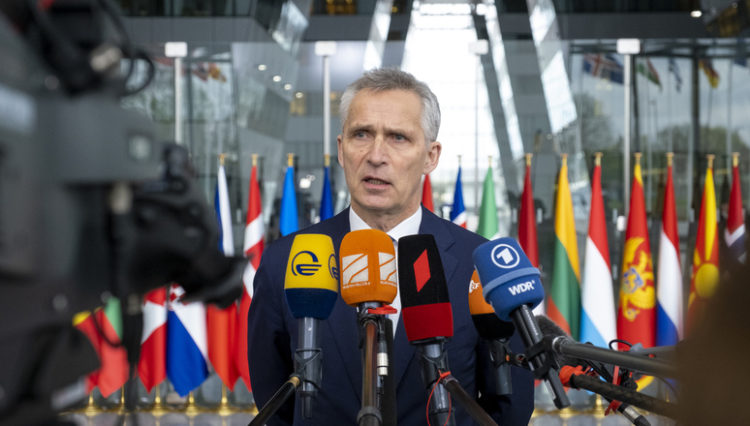NATO intends to deploy permanent military forces on the Russian border of member-states, Estonia and Latvia, to defend against any potential military offensives by Russia. The move is an effort to defend NATO members from further aggression by Putin as tensions continue in Europe.
NATO Secretary-General Jens Stoltenberg revealed the alliance’s plans in an interview with The Telegraph. According to him, the alliance is “in the midst of a very fundamental transformation,” which will show Russian President Vladimir Putin “the long-term consequences” of his aggressions.
These bases are typically built and purchased by the host country and NATO forces pre-position tanks, ammunition, artillery and other implements of war and supplies, while troops serve there on rotational deployments. So while the bases and equipment would be permanent fixtures, the troops themselves would not be. This will add to the stresses of an ever-shrinking number of troops in the US Army overall and increase the number and length of their deployments overseas.
“What we see now is a new reality, a new normal for European security. Therefore, we have now asked our military commanders to provide options for what we call a reset, a longer-term adaptation of NATO,” Stoltenberg said. He added that NATO leaders are expected to make the final decision during the alliance’s summit in Madrid this June.
Currently, NATO’s presence with its border in Russia is limited to a “tripwire” force, which serves as a symbol of the alliance’s intent to defend rather than actually holding off an attack. The force grew tenfold to 40,000 military personnel from different member states after Putin began his conquest of Ukraine.
It can also be remembered that NATO had announced it would be deploying 4 new battlegroups in Bulgaria, Hungary, Romania, and Slovakia. The deployment aims to bolster its eastern flank and equip these countries with combat-ready battalion units. This gives a total of 8 multinational NATO battlegroups along the eastern flank, not counting the prospective new, permanent military force.
Stoltenberg also noted that the Pacific threat in China would also be considered in the alliance’s “Strategic Concept,” the group’s strategic document. This is the first time Beijing had been featured in the NATO document as Moscow and Beijing appear to be “working more and more closely together,” the NATO chief said.
Just last month, the United Kingdom announced that it would double the total number of troops it has deployed in Eastern Europe and create a new dispatch in Bulgaria. This was in line with NATO leaders agreeing to bolster the alliance’s presence on their eastern flank. However, Stoltenberg’s statement reveals the alliance intends to go much further than what was previously expected.
NATO and Johnson’s Unexpected Visit to Kyiv
Slava Ukraini 🇬🇧 🇺🇦 pic.twitter.com/u6vGYqmK4V
— Boris Johnson (@BorisJohnson) April 9, 2022
The announcement of NATO’s new military plans came as United Kingdom’s Prime Minister Boris Johnson made a surprise trip to the Ukrainian capital of Kyiv. He met with Ukrainian President Volodymyr Zelensky and went around the capital in a “show of solidarity” for the war-torn country.
This meeting comes after the UK had pledged to send Mastiff armored vehicles to Ukraine following its initial military support package of the Starstreak MANPADS and NLAWs.
The two leaders exchanged praise for their respective countries in a joint television broadcast.
“Ukraine has defied the odds and pushed back Russian forces from the gates of Kyiv, achieving the greatest feat of arms of the 21st century,” Johnson said. “I think that the Ukrainians have shown the courage of a lion, and you Volodymyr have given the roar of that lion.”
British Prime Minister Boris Johnson with Ukrainian President Volodymyr Zelensky during the latter’s visit to Kyiv (The Kyiv Independent/Twitter)
Reports say that less than half a dozen of the UK Prime Minister’s closest staff knew of the visit. An announcement to the public was made via the Ukrainian Embassy to the UK Twitter page, showing an image of Zelensky and Johnson in a meeting room.
“Having been here in Kyiv for just a few hours, I have no doubt at all that an independent sovereign Ukraine will rise again thanks above all to the heroism, the courage of the people of Ukraine.”
The UK and the US have been at the front of pushing for sanctions against Russia as well as providing much-needed aid to Ukraine.
“The Prime Minister of the United Kingdom Boris Johnson is one of the most principled opponents of the Russian invasion, a leader in sanctions pressure on Russia and defense support of Ukraine. Welcome to Kyiv my friend,” Zelensky said after his meeting with Johnson.
Johnson also took the opportunity to unveil another package of military and financial aid for Ukraine. It included an additional $500 million loan guarantee in World Bank lending to Ukraine. This takes the UK’s total loan guarantee to $1 billion.
Back in London, conservative members of the UK parliament and ministers have been pushing for higher defense spending as the conflict in Ukraine drags on. NATO’s Stoltenberg said he would “welcome” the budget increase from Britain but insists that ensuring the alliance members meet the minimum contribution of 2% of their GDP is a top priority.











COMMENTS
You must become a subscriber or login to view or post comments on this article.